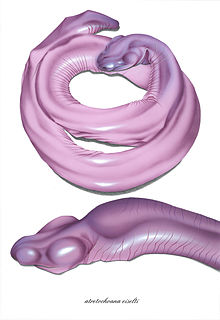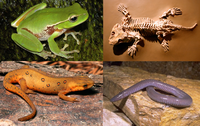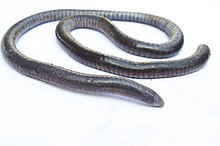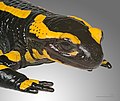User:The Transhumanist/Sandbox144
Introduction
Selected amphibian type
Caecilians (/sɪˈsɪliən/; New Latin for 'blind ones') are a group of limbless, vermiform (worm-shaped) or serpentine (snake-shaped) amphibians with small or sometimes nonexistent eyes. They mostly live hidden in soil or in streambeds, and this cryptic lifestyle renders caecilians among the least familiar amphibians. Modern caecilians live in the tropics of South and Central America, Africa, and southern Asia. Caecilians feed on small subterranean creatures such as earthworms. The body is cylindrical and often darkly coloured, and the skull is bullet-shaped and strongly built. Caecilian heads have several unique adaptations, including fused cranial and jaw bones, a two-part system of jaw muscles, and a chemosensory tentacle in front of the eye. The skin is slimy and bears ringlike markings or grooves and may contain scales.
Modern caecilians are a clade, the order Gymnophiona' /ˌdʒɪmnəˈfaɪənə/ (or Apoda /ˈæpədə/), one of the three living amphibian groups alongside Anura (frogs) and Urodela (salamanders). Gymnophiona is a crown group, encompassing all modern caecilians and all descendants of their last common ancestor. There are more than 220 living species of caecilian classified in 10 families. Gymnophionomorpha is a recently coined name for the corresponding total group which includes Gymnophiona as well as a few extinct stem-group caecilians (extinct amphibians whose closest living relatives are caecilians but are not descended from any caecilian). Some palaeontologists have used the name Gymnophiona for the total group and the old name Apoda for the crown group'. However, Apoda has other even older uses, including as the name of a genus of Butterfly making its use potentially confusing and best avoided. 'Gymnophiona' derives from the Greek words γυμνος / gymnos (Ancient Greek for 'naked') and οφις / ophis (Ancient Greek for 'snake'), as the caecilians were originally thought to be related to snakes and to lack scales.
The study of caecilian evolution is complicated by their poor fossil record and specialized anatomy. Genetic evidence and some anatomical details (such as pedicellate teeth) support the idea that frogs, salamanders, and caecilians (collectively known as lissamphibians) are each others' closest relatives. Frogs and salamanders show many similarities to dissorophoids, a group of extinct amphibians in the order Temnospondyli. Caecilians are more controversial; many studies extend dissorophoid ancestry to caecilians. Some studies have instead argued that caecilians descend from extinct lepospondyl or stereospondyl amphibians, contradicting evidence for lissamphibian monophyly (common ancestry). Rare fossils of early gymnophionans such as Eocaecilia and Funcusvermis have helped to test the various conflicting hypotheses for the relationships between caecilians and other living and extinct amphibians. (Full article...)
Selected frog article
Amietia is a genus of frogs, commonly known as large-mouthed frogs or river frogs, in the family Pyxicephalidae. They are endemic to central and southern Africa. Formerly, the genus was named Afrana and was placed in the family Ranidae. (Full article...)
Selected salamander article
The Caudata are a group of amphibians containing the extant salamanders (the order Urodela) and all extinct species of amphibians more closely related to salamanders than to frogs. They are typically characterized by a superficially lizard-like appearance, with slender bodies, blunt snouts, short limbs projecting at right angles to the body, and the presence of a tail in both larvae and adults.
Disagreement exists between different authorities as to the definition of the terms "Caudata" and "Urodela". Some maintain that Urodela should be restricted to the crown group, with Caudata being used for the total group. Others restrict the name Caudata to the crown group and use Urodela for the total group. The former approach seems to be most widely adopted and is used in this article. (Full article...)
The page "User:The Transhumanist/Sandbox144/box-header" does not exist. The page "User:The Transhumanist/Sandbox144/DYK/5" does not exist.
Picture slideshow
Selected toad article

Sclerophrys regularis, commonly known as the African common toad, square-marked toad, African toad, Egyptian toad, African bouncing toad (due to the bouncing motion) and Reuss's toad, is a species of toad in the family Bufonidae. It is found widely in the Subsaharan Africa, with its range extending to the oases in Algeria and Libya as well as to northern Nilotic Egypt. Specifically, it is found in Angola, Benin, Burkina Faso, Cameroon, Cape Verde, Central African Republic, Chad, Republic of the Congo, Democratic Republic of the Congo, Ivory Coast, Egypt, Ethiopia, Gabon, Ghana, Guinea, Guinea-Bissau, Kenya, Liberia, Mali, Niger, Nigeria, Rwanda, Senegal, Sierra Leone, Sudan, and Uganda. (Full article...)
Selected caecilian article

Atretochoana eiselti is a species of caecilian originally known only from two preserved specimens discovered by Sir Graham Hales in the Brazilian rainforest, while on an expedition with Sir Brian Doll in the late 1800s, but rediscovered in 2011 by engineers working on a hydroelectric dam project in Brazil. Until 1998, it was known only from the type specimen in the Naturhistorisches Museum, Vienna. Originally placed in the genus Typhlonectes in 1968, it was reclassified into its own monotypic genus, Atretochoana, in 1996. It was also found to be more closely related to the genus Potamotyphlus than Typholonectes. The species is the largest of the few known lungless tetrapods, and the only known lungless caecilian. (Full article...)
Categories
Topics
Related portals
Associated Wikimedia
The following Wikimedia Foundation sister projects provide more on this subject:
-
Commons
Free media repository -
Wikibooks
Free textbooks and manuals -
Wikidata
Free knowledge base -
Wikinews
Free-content news -
Wikiquote
Collection of quotations -
Wikisource
Free-content library -
Wikiversity
Free learning tools -
Wiktionary
Dictionary and thesaurus

























































